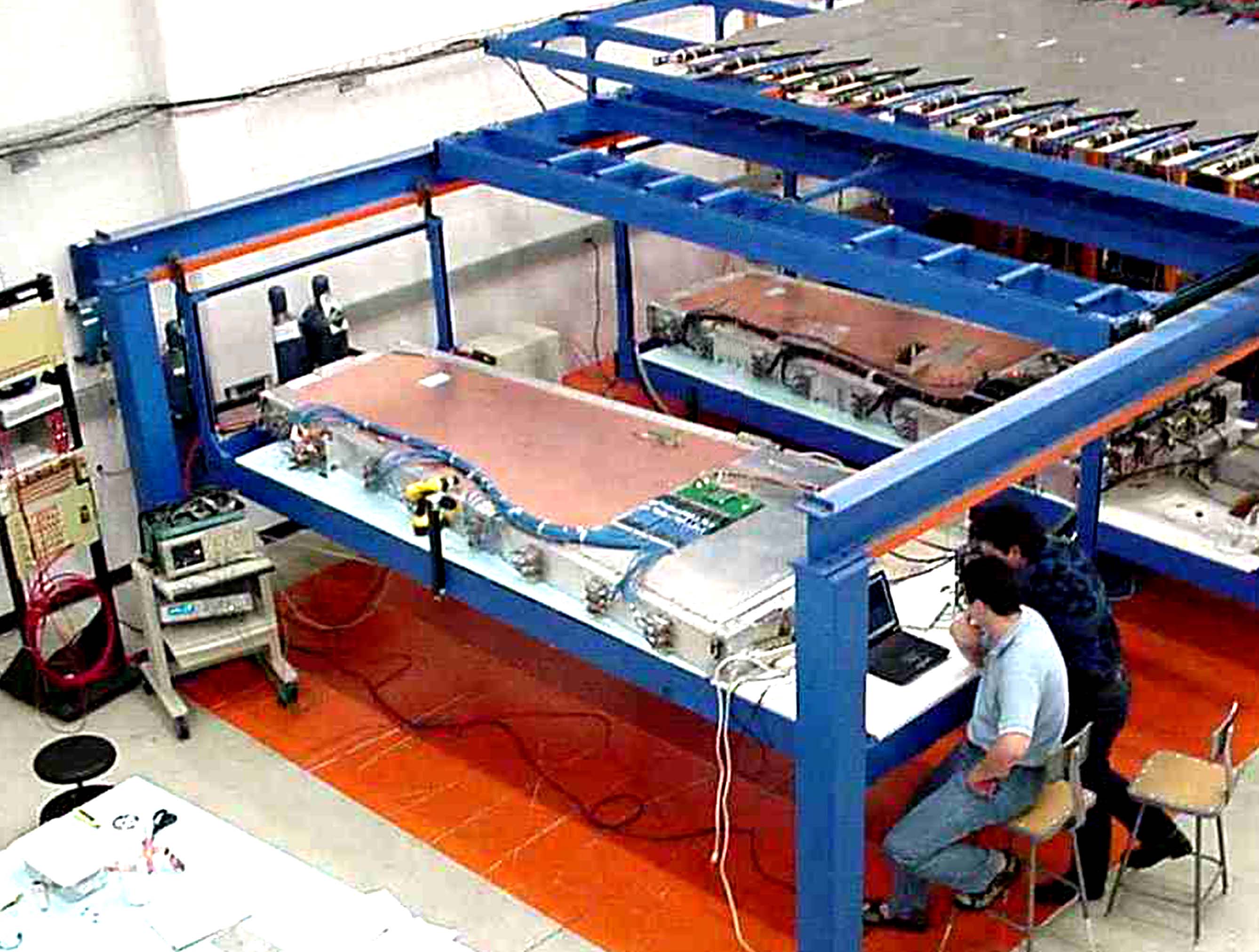The UF group research program at the CMS experiment at LHC
Professors: Paul Avery, Rick Field (Emeritus), Jocobo Konigsberg, Andrey Korytov, Konstantin Matchev, Guenakh Mitselmakher
The success of the group has only been possible thanks to the dedicated and most-talented team of students, postdocs, and engineers.
The Large Hadron Collider (LHC) at CERN provides proton-proton collisions at an unprecedented energy exceeding protons’ mass by nearly 104 times and at a rate of about 109 collisions per second. The Compact Muon Solenoid (CMS) experiment, seen on the left, is one of the two general purpose detectors at LHC. The CMS Detector is about 15 m high and 20 m long, weighs about 10,000 tons, and contains the world’s largest-stored-energy superconducting magnet. The detector is built by an international collaboration of nearly 200 institutions at a cost of about $0.5B.

The UF group is among the lead institutions in CMS. The group is internationally recognized for its prominent contributions to the CMS Detector design, construction, operation, and for the group’s role in the cutting-edge physics program at CMS, including the discovery of the Higgs boson.
The LHC and the LHC experiments are approved to undergo major upgrades. The upgraded LHC, known as High-Luminosity LHC (HL-LHC), will start its operations around 2026 and is projected to operate beyond mid-2030s. During this time, the dataset collected by the considerably upgraded LHC experiments will exceed the ones originally planned for the LHC program by a factor of 10. Such datasets together with upgraded capabilities of the LHC experiments will allow for probing the nature of constituents of matter and fundamental forces with truly exceptional sensitivities. The UF group is actively involved in the CMS Detector upgrades and in preparations for the future data analyses, both for new physics searches and precision measurements.
Instrumentation and Computing
From the early 1990s, Prof. Mitselmakher led the development of the endcap muon detection system and co-led the CMS Muon System project for ~20 years, Prof. Korytov was responsible at the same time for managing the design and construction of the 468 Cathode Strip Chambers (CSC) for the endcap muon system. The picture on the left shows commissioning of one of Cathode Strip Chambers at the UF Cosmic Ray Stand (total 75 CSCs were commissioned at UF). Prof. Avery helped establish the LHC Grid computing model in the US and is the head of the UF US-CMS Tier-2 computing center with O(10K) CPU cores and many Petabytes of disk space, one of only a few such sites in the US.

At present, Professors Avery, Konigsberg, Korytov, Mitselmakher, as well as their postdocs and graduate students, are strongly involved in CMS Detector ongoing operation and in the upcoming CMS upgrades for the High Luminosity phase of the LHC program. The main focus of the UF group upgrade effort remains on the muon detectors and muon trigger.
Physics Program
 Higgs boson: The Higgs boson is at the core of the UF group physics effort, with the main focus being on the Higgs boson decays to four leptons H→ZZ→4l (Korytov, Mitselmakher), a pair of b-quarks H→bb (Konigsberg), and a combination of all Higgs boson analyses in CMS (Korytov). The UF group led a number of Higgs boson searches in CMS that culminated with the discovery of the Higgs boson in 2012 established in a combination of five search analyses, with H→ZZ→4l and H→bb being two of them; the subsequent observations of the Higgs boson exclusive decays to four leptons and pairs of b-quarks; establishing the Higgs boson’s spin-parity properties; precision measurements of its mass (fundamental parameter of the Standard Model); and detailed studies of the Higgs boson production mechanisms. The program of studying properties of the discovered Higgs boson continues.
Higgs boson: The Higgs boson is at the core of the UF group physics effort, with the main focus being on the Higgs boson decays to four leptons H→ZZ→4l (Korytov, Mitselmakher), a pair of b-quarks H→bb (Konigsberg), and a combination of all Higgs boson analyses in CMS (Korytov). The UF group led a number of Higgs boson searches in CMS that culminated with the discovery of the Higgs boson in 2012 established in a combination of five search analyses, with H→ZZ→4l and H→bb being two of them; the subsequent observations of the Higgs boson exclusive decays to four leptons and pairs of b-quarks; establishing the Higgs boson’s spin-parity properties; precision measurements of its mass (fundamental parameter of the Standard Model); and detailed studies of the Higgs boson production mechanisms. The program of studying properties of the discovered Higgs boson continues.
Beyond Standard Model (BSM) physics: The UF group actively pursues a number of searches for new physics whose existence is strongly implied by a number of the SM shortcomings (existence of dark matter observed in the Universe, matter-antimatter asymmetry in the Universe, lightness of the Higgs boson mass, non-zero and extremely small neutrino masses, etc.). Among the UF-led analyses are searches for lepton-flavor violating processes, such as τ→3μ decays (Korytov, Mitselmakher); and for deviations of the discovered Higgs boson’s properties from those predicted by the SM (Konigsberg, Korytov, Mitselmakher).
BSM Phenomenology: Matchev leads an effort on the phenomenology of new physics at LHC, covering models of BSM Higgs bosons, SUSY, extra dimensions, and more.